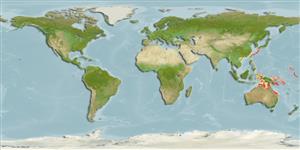>
Gobiiformes (Gobies) >
Gobiidae (Gobies) > Gobiinae
Etymology: Trimma: Greek, trimma, -atos = something crushed (Ref. 45335); readerae: Named for Sally Reader, Australian Museum..
Environment: milieu / climate zone / depth range / distribution range
ນິເວດວິທະຍາ
ສັດທະເລ ກ່ຽວກັນຫີນ; ລະດັບຄວາມເລິກ 0 - 40 m (Ref. 100726). Subtropical
ການແຜ່ກະຈາຍ
ປະເທດ | ເຂດ FAO | ລະບົບນິເວດ | ການປະກົດຕົວ | Point map | ການແນະນຳ | Faunafri
Western Pacific: known from mid to outer reefs on the Great Barrier Reef, and inshore reefs of Western Australia, but rarely from the Coral Sea and Timor Sea. Tentatively included, in what appears to represent a species complex, specimens and images collected from the Solomon Islands, Indonesia, Borneo, New Guinea, Japan and the Marshall Islands (also based on the spotting pattern on the cheek).
ຂະໜາດ / ນ້ຳໜັກ / Age
Maturity: Lm ? range ? - ? cm
Max length : 2.6 cm SL ຕົວຜູ້/ບໍ່ມີເພດ; (Ref. 100726); 2.3 cm SL (female)
Short description
ສະລີລະວິທະຍາ | ການວັດແທກຮູບຮ່າງລັກສະນະພາຍນອກຂອງດິນ,ສັດ,ປາ…
ຄີ (ໜາມ)ແຂງຢູ່ຫຼັງປາ (ທັງໝົດ): 7; ຄີຫຼັງຂອງປາ (ຄີອ່ອນ) (ທັງໝົດ): 8-10; ຄີ(ໜາມ) ແຂງຢູ່ຄີກົ້ນປາ
ກຸ່ມປາກະດູກແຂງ
ຄວາມຖີ່ຂອງກຸ່ມຖ່າຍທອດພັນ
ປາທີ່ມີການເຄື່ອນຍ້າຍຈາກທະເລໄປຫານ້ຳຈືດ ແລະນ້ຳຈືດຫາທະເລ
ປາທີ່ມີການເຄື່ອນຍ້າຍຈາກທະເລແລະໄປໄຂ່ຢູ່ນ້ຳຈືດ
ຄີກົ້ນຂອງປາ
ສັດທີ່ມີກະດູກສັນຫັຼງ
ການຖ່າຍທອດທາງກຳມະພັນຈາກພໍ່ແມ່ຫາລູກ 1; ຄີກົ້ນຂອງປາ: 8. This species is distinguished by the following characters: adults with a moderately deep interorbital trench and a shallow groove behind the upper half of the eye, largely disappearing below the papilla at the posterodorsal margin of the eye; predorsal is almost completely covered with ctenoid scales, with 3-6 rows crossing the midline anteriorly to just behind the interorbital trench, anterior-most scale on the midline just behind a small naked patch posterior to the eyes, the scale not larger than the second scale on the midline; no scales on opercle and preopercle; pectoral-fin base is covered with 5-6 large cycloid scales, lowermost 3-4 scales smaller than upper two scales; prepelvic area with a small scale covering basal membrane between the two fins and followed anteriorly by a large scale between the bases of fins, and 3 rows of large cycloid scales anteriorly; central pectoral rays are branched; pelvic fins are widely separate, connected only at their bases, the distance between the bases of the fins about three-quarters to equal to the base of each pelvic fin; the fifth pelvic ray is usually unbranched, rarely with a single branch (2 terminal tips); fifth ray 60-80% the length of the fourth; the second dorsal spine usually longest, elongated into a long filament in adult males, reaching to beyond the end of the second dorsal fin, while females sometimes with a short filament reaching to above the anterior rays of the second dorsal fin; the third spine sometimes a short filament; D2 usually I 9 and anal rays usually I 8; below the eye are two distinct round red to reddish-orange spots; the branchiostegal membranes with distinct bright reddish-orange spots; body possess small yellow to red spots in 4-5 irregular rows anteriorly and three rows on the caudal peduncle (Ref. 100726).
This species is usually found in back reef leeward areas (Ref. 100726).
Life cycle and mating behavior
ການຈະເລີນເຕັມໄວ | ການສືບພັນ | ການວາງໄຂ່ | ໄຂ່ | ຄວາມດົກຂອງໄຂ່ປາ | ຕົວອ່ອນ
Winterbottom, R. and D.F. Hoese, 2015. A revision of the Australian species of Trimma (Actinopterygii, Gobiidae), with descriptions of six new species and redescriptions of twenty-three valid species. Zootaxa 3934(1):001-102. (Ref. 100726)
IUCN Red List Status (Ref. 130435)
Threat to humans
Harmless
Human uses
ຂໍ້ມູນຕື່ມອີກ
ປະເທດເຂດ FAOລະບົບນິເວດການປະກົດຕົວການແນະນຳStocksນິເວດວິທະຍາອາຫານລາຍການອາຫານການບໍລິໂພກອາຫານອັດຕາ
ຊື່ສາມັນຄຳສັບຄ້າຍຄືກັນການເຜົາໃໝ້ພະລັງງານໂດຍປ່ຽນທາດອາຫານໃນຮ່າງກາຍໃຫ້ກາຍເປັນຊີ້ນແລະໜັງຜູ້ລ້າການສຶກສາຜົນກະທົບຂອງສານຜິດທີ່ມີຜົນກະທົບຕໍ່ລະບົບນິເວດການສືບພັນການຈະເລີນເຕັມໄວການວາງໄຂ່ການສັງລວມການວາງໄຂ່ຄວາມດົກຂອງໄຂ່ປາໄຂ່Egg development
Age/Sizeການເຕີບໃຫຍ່Length-weightLength-lengthLength-frequenciesການວັດແທກຮູບຮ່າງລັກສະນະພາຍນອກຂອງດິນ,ສັດ,ປາ…ສະລີລະວິທະຍາຕົວອ່ອນການປ່ຽນແປງຂອງຕົວອ່ອນການທົດແທນທີ່ຄວາມອຸດົມສົມບູນBRUVS
ເອກະສານອ້າງອີງການລ້ຽງສັດນ້ຳຂໍ້ມູນການລ້ຽງສັດນ້ຳສາຍພັນກຳມະພັນElectrophoresesການຖ່າຍທອດທາງກຳມະພັນຈາກພໍ່ແມ່ຫາລູກພະຍາດການປຸງແຕ່ງNutrientsMass conversion
ຜູ້ຮ່ວມມືຮູບStamps, Coins Misc.ສຽງຫອຍມີພິດຊະນິດນຶ່ງທີ່ອາໄສໃນທະເລຄວາມໄວປະເພດການລອຍເນື້ອທີ່ເຫືອກOtolithsສະໝອງວິໄສທັດ
ເຄື່ອງມື
Special reports
Download XML
ແຫຼ່ງອີນເຕີເນັດ
Estimates based on models
Phylogenetic diversity index (Ref.
82804): PD
50 = 0.5000 [Uniqueness, from 0.5 = low to 2.0 = high].
Bayesian length-weight: a=0.01023 (0.00477 - 0.02194), b=3.02 (2.84 - 3.20), in cm total length, based on LWR estimates for this (Sub)family-body shape (Ref.
93245).
ຄວາມຢືດຢຸ່ນ (Ref.
120179): ສູງ, ປະຊາກອນຕຳ່ສຸດທີ່ໃຊ້ເວລາສອງໜ້ອຍກວ່າ 15 ເດືອນ (Preliminary K or Fecundity.).
Fishing Vulnerability (Ref.
59153): Low vulnerability (10 of 100).
